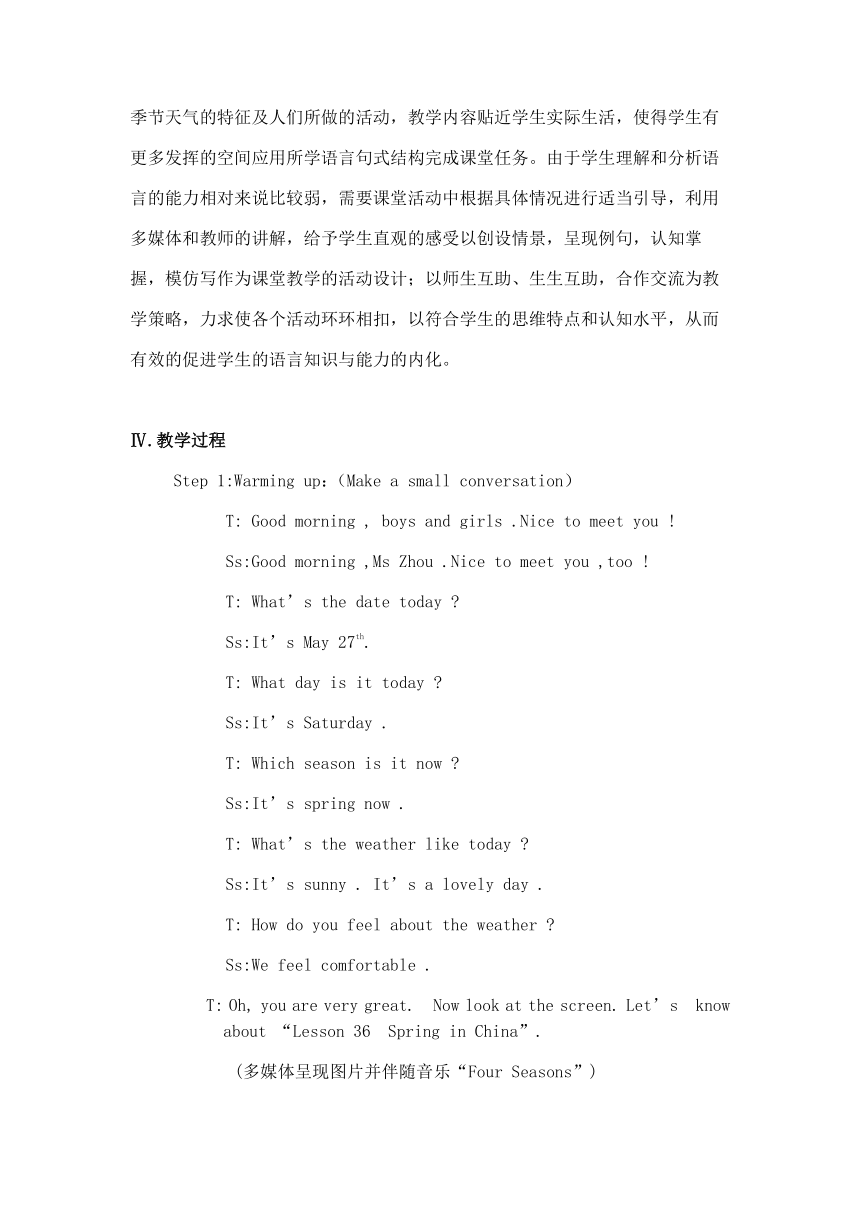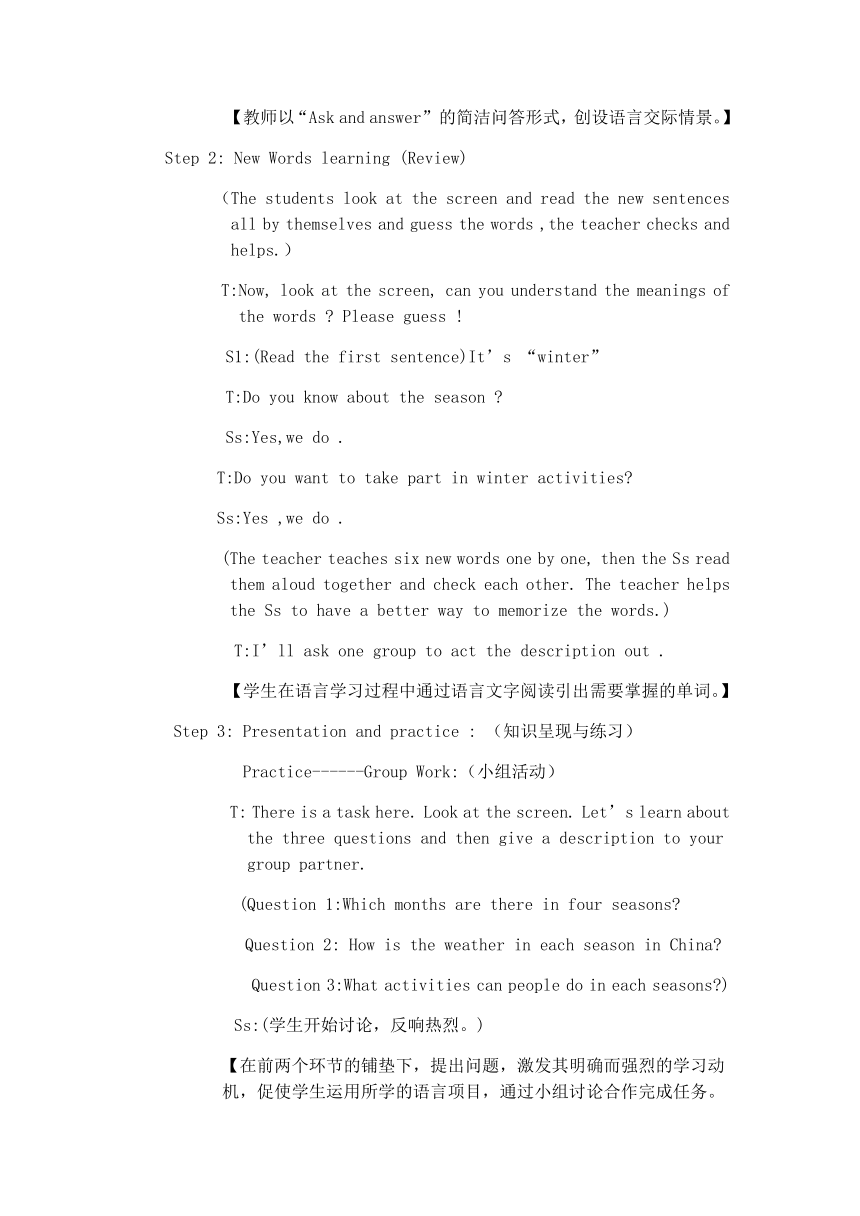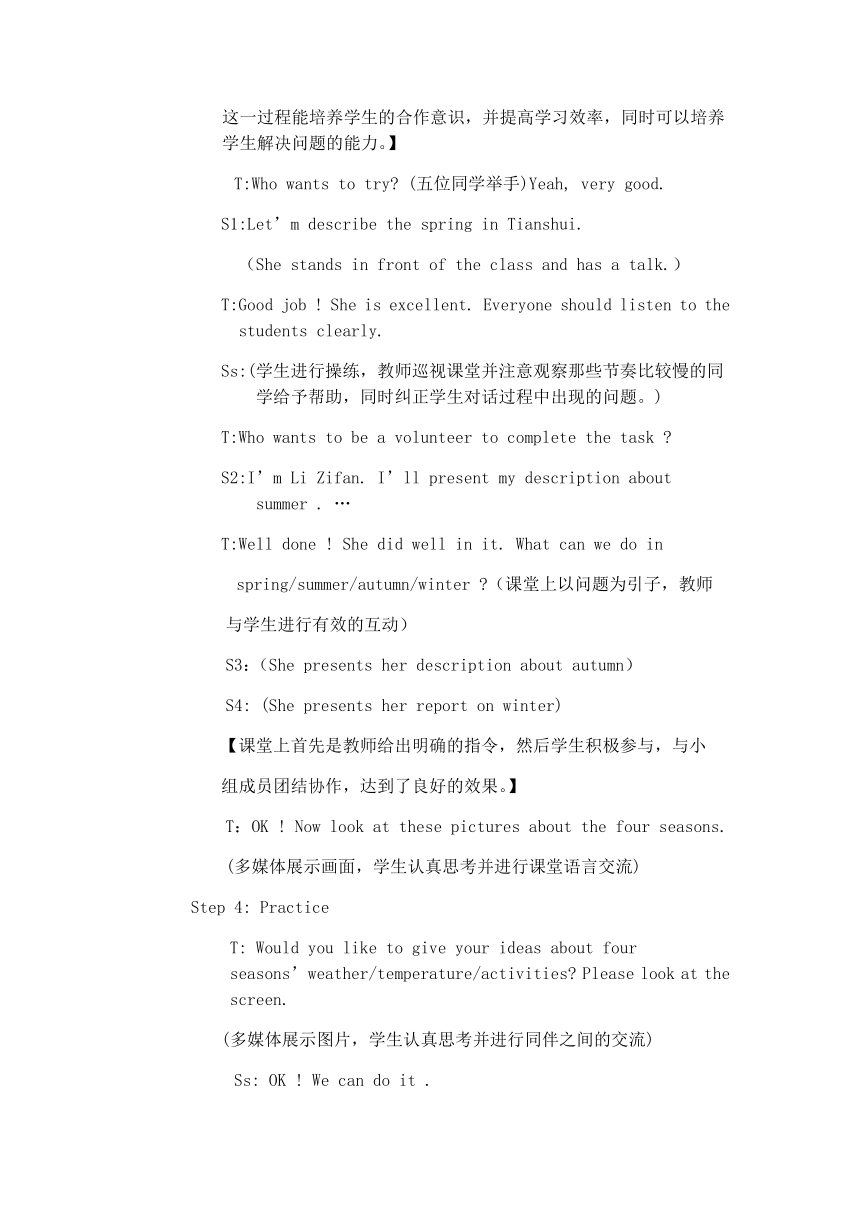冀教版英语七年级下册Unit 6 Seasons Lesson 36 Spring in China教案
文档属性
| 名称 | 冀教版英语七年级下册Unit 6 Seasons Lesson 36 Spring in China教案 |  | |
| 格式 | zip | ||
| 文件大小 | 40.5KB | ||
| 资源类型 | 教案 | ||
| 版本资源 | 冀教版 | ||
| 科目 | 英语 | ||
| 更新时间 | 2020-05-01 20:23:01 | ||
图片预览





文档简介
冀教版七年级(下) Unit 6 Seasons
Lesson 36 Spring in China
Ⅰ.教学内容解析
1. 该课题安排在冀教版教材七年级(下)Unit Six Seasons的最后一课Lesson 36 Spring in China单元教学内容以“Four Seasons”为话题创设真实的语言交际情景,展开课堂教学活动。强调以学生为主体的有意义的语言实践活动,在课堂教与学的互动过程中运用所学句型进行语言操练,并激发学生感知大自然的美好并享受这样的美好带给我们的快乐。
2. 创设情景教学模式,采用完成课题式的任务教学方式( Project Approach)以达到本节课的教学目的。Task 1:Discussion(开拓思维,加强记忆);Task 2:Reading(获取信息,输入文本);Task 3:Summarize(加强记忆,概括整理);Task 4:Retelling(深化记忆,情境突破);Task 5:Free Talk(以思维导图启发学生创造性的应用所学知识);Task 6:Writing(拓展应用,输出文本)。
3. 本课的学习以描述四季天气、活动的语言交际表达内容为主,通过六个任务的设置,有效整合本单元的教材内容,逐阶段激发学生学习英语的兴趣,以英语课堂实践活动Group Work; Pair Work; Individual Work及Discussion; Writing为教学过程中的操作环节,引导学生积极主动地思考,自主学习,合作探究,从而使学生掌握本节课所学知识内容。
4. 课堂教学中反复操练四季天气及活动的句型,以加深记忆;以答疑解惑的教师与学生间的合作互动方式突破教学重点;以语境创建,铺设思维导图及教师的亲身参与写作任务并给出作文范例,突破了写作的教学难点。
Ⅱ.教学目标
1.知识与能力目标
a.使学生熟练掌握句式结构“What a lovely season!/ is my favourite season./ What is spring like in China/Canada?/The temperature is not too hot or too cold.
b.掌握句型结构“I’m going to the ...with .../We are going to...描述季节活动;/How exciting ! /What strange weather it is! /How happily they play together!表达情感。
c.使学生理解描述季节天气及活动时句型中的谓语动词时态可以运用一般现在时及一般将来时并掌握其语法规则。
2.教学重点、难点及教学突破
⑴.教学重点
a.掌握句型结构“What a lovely season!/ is my favorite season./ What is spring like in China/Canada?/The temperature is not too hot or too cold.并能在课堂操练中熟练运用。
b.掌握句型结构“掌握句型结构“I’m going to the ...with .../We are going to...描述季节活动;/How exciting ! /What strange weather it is! /How happily they play together!表达情感并能在课堂操练中熟练运用。
c.探究谓语动词的时态转换及应用的不同,并掌握其语法规则。
⑵.教学难点
本课难点在于运用句型描述天气及活动时句子结构中的谓语动词的时态转换及正确使用。
⑶.教学突破
针对教学重点和难点,课堂教学活动设计中,注重学生课堂活动练习,给学生足够的时间进行巩固训练。模仿例句体验描述天气及活动的句式及动词时态的准确把握,形成英语表达的敏感意识,产生熟能生巧的效果。
Ⅲ.学情分析
在知识积累方面,学生已经掌握了一定的词汇和句型,具备了一定的了解
语境认知语言并进行模仿造句的能力,对语言学习的热情也逐步增加。他们更
感兴趣的是如何用英语来表述与现实生活息息相关的话题并在课堂互动交流
活动中获得独特的体验,从而在体验中感悟语言,在体验中生成新知识新经验。
本课通过“Spring in China” 话题展开教学,以“四季”的话题引出在每一
季节天气的特征及人们所做的活动,教学内容贴近学生实际生活,使得学生有
更多发挥的空间应用所学语言句式结构完成课堂任务。由于学生理解和分析语
言的能力相对来说比较弱,需要课堂活动中根据具体情况进行适当引导,利用
多媒体和教师的讲解,给予学生直观的感受以创设情景,呈现例句,认知掌
握,模仿写作为课堂教学的活动设计;以师生互助、生生互助,合作交流为教
学策略,力求使各个活动环环相扣,以符合学生的思维特点和认知水平,从而
有效的促进学生的语言知识与能力的内化。
Ⅳ.教学过程
Step 1:Warming up:(Make a small conversation)
T: Good morning , boys and girls .Nice to meet you !
Ss:Good morning ,Ms Zhou .Nice to meet you ,too !
T: What’s the date today ?
Ss:It’s May 27th.
T: What day is it today ?
Ss:It’s Saturday .
T: Which season is it now ?
Ss:It’s spring now .
T: What’s the weather like today ?
Ss:It’s sunny . It’s a lovely day .
T: How do you feel about the weather ?
Ss:We feel comfortable .
T: Oh, you are very great. Now look at the screen. Let’s know about “Lesson 36 Spring in China”.
(多媒体呈现图片并伴随音乐“Four Seasons”)
【教师以“Ask and answer”的简洁问答形式,创设语言交际情景。】
Step 2: New Words learning (Review)
(The students look at the screen and read the new sentences all by themselves and guess the words ,the teacher checks and helps.)
T:Now, look at the screen, can you understand the meanings of the words ? Please guess !
S1:(Read the first sentence)It’s “winter”
T:Do you know about the season ?
Ss:Yes,we do .
T:Do you want to take part in winter activities?
Ss:Yes ,we do .
(The teacher teaches six new words one by one, then the Ss read them aloud together and check each other. The teacher helps the Ss to have a better way to memorize the words.)
T:I’ll ask one group to act the description out .
【学生在语言学习过程中通过语言文字阅读引出需要掌握的单词。】
Step 3: Presentation and practice : (知识呈现与练习)
Practice------Group Work:(小组活动)
T: There is a task here. Look at the screen. Let’s learn about the three questions and then give a description to your group partner.
(Question 1:Which months are there in four seasons?
Question 2: How is the weather in each season in China?
Question 3:What activities can people do in each seasons?)
Ss:(学生开始讨论,反响热烈。)
【在前两个环节的铺垫下,提出问题,激发其明确而强烈的学习动机,促使学生运用所学的语言项目,通过小组讨论合作完成任务。这一过程能培养学生的合作意识,并提高学习效率,同时可以培养学生解决问题的能力。】
T:Who wants to try? (五位同学举手)Yeah, very good.
S1:Let’m describe the spring in Tianshui.
(She stands in front of the class and has a talk.)
T:Good job ! She is excellent. Everyone should listen to the students clearly.
Ss:(学生进行操练,教师巡视课堂并注意观察那些节奏比较慢的同学给予帮助,同时纠正学生对话过程中出现的问题。)
T:Who wants to be a volunteer to complete the task ?
S2:I’m Li Zifan. I’ll present my description about summer . …
T:Well done ! She did well in it. What can we do in
spring/summer/autumn/winter ?(课堂上以问题为引子,教师
与学生进行有效的互动)
S3:(She presents her description about autumn)
S4: (She presents her report on winter)
【课堂上首先是教师给出明确的指令,然后学生积极参与,与小
组成员团结协作,达到了良好的效果。】
T:OK ! Now look at these pictures about the four seasons.
(多媒体展示画面,学生认真思考并进行课堂语言交流)
Step 4: Practice
T: Would you like to give your ideas about four seasons’weather/temperature/activities? Please look at the screen.
(多媒体展示图片,学生认真思考并进行同伴之间的交流)
Ss: OK ! We can do it .
(部分学生积极举手发言,课堂氛围比较热烈)
T(强调语气):When we talk about seasons, please pay more attention to these points:weather/temperature/activities/
Feelings.
【针对课堂语言交流中同学的疑问及其出现的语句问题,老师抓住时机解读原因,并反复操练,以达成“熟能生巧”的结果。课堂中关键是教师在要有一双慧眼,善于发现同学们的疑难点。后续的课堂练习很顺利。】
T: Who knows Li Ming’s favourite season?
Ss: It’s spring.
T: What is the spring like in China?
(多媒体呈现任务:Read the lesson and find out the answers to the questions)
Q1: What’s spring like in Li Ming’s city?
Q2: Where is Li Ming going with his parents?
Q3: What are they going to do?
Q4: How does Li Ming feel?
【回归文本,阅读理解; 带着问题,获得信息; 培养学生的阅读能力。】
T: Everyone can find out something important in the text.
(限定时间,同伴合作,相互补充,相互交流)
(S1/S2/S3/S4 answers the four questions.)
T: After reading the text for the first time ,let’s complete Task 3:Fill in the blanks to summarize the passage.
(Ss read the passage for the second time.)
【进一步熟悉教学的文本,在阅读中以问题的设置形成线索,帮助学生记忆有用的重要的信息】
T:Now, Let’s finish the task.(Point at the passage on the screen )
T:Who wants to be a volunteer?
S1/S2/S3/S4:We can do it!
T:Well done!
T:OK! You have a good job!
【深入教学文本展开句型操练,进一步巩固熟练本节课的重点句型,引导并鼓励学生自由发挥,自主创新,有效运用了所学的句型。】
T:Are you feeling happy ?
(同学们踊跃回答问题,积极参与课堂活动。)
T: OK. Now let’s read the text for the third time. Can you describe something important?
(多媒体展示Task 4:Try to retell the text using your own words)
T:What is spring like in China ?
S1: Spring is a lovely season.
S2: The temperature is not too hot or too cold.
S3: The rain and sun make all the trees and grass green again.
S4: Beautiful flowers are everywhere .
S5: Everything looks new and fresh.
T: What activities can Li Ming do with his family?
S6: Li Ming is going to the countryside with his parents tomorrow.
S7: They are going to pick strawberries and have a picnic.
S8: They’ll stay outside and enjoy the nice weather.
(学生在教师的引导下,通过已学的词汇和句型认知,展开课堂学习的进一步操练,强化学生运用所学词汇造句的能力。)
T:How does Li Ming feel in spring?
Ss: Li Ming feels very excited.
T: OK. You are great.
【通过问题设置让学生将所学语言目标全部运用起来,在课堂上进行行之有效的练习,从效果上来看促进了学生对教学文本知识的清晰理解,照顾了不同层次学生的学习需求。】
T: Excellent ! All of you have a good memory . Now let’s relax .
Here is a Mind Mapping .Can you present the information?
(大屏幕呈现了一个思维导图,教师引导学生逐步描述,养成学生独立思考的习惯。)
T:Now,there is another task. Task 5:Free talk in pairs
Look at the topic: Spring in Canada
【教师充分利用板书罗列完成任务所需的信息weather/temperature/months/activities/clothes形成语言表述的线索】
(多媒体展示加拿大春天的风景图片,给学生直观印象完成语言构思)
(同学们进行同桌之间的交流)
T:After discussing, can you describe the spring in Canada?
OK.One by one give us your presentation.
S1:The weather in Canada is warm and windy, sometimes
it’s a little cool.
T:You are special! I’m proud of you.
S2:There are three months in spring in Canada.
They are March, April and May.
S3:People enjoy the sunshine, fish at the lake and go boating.
S4:People feel enjoyable and comfortable.
T:You are special! I’m proud of you.
【课堂上教师的评价非常重要。一方面它是肯定学生学习有效率的开心果,另一方面它又是引导学生进一步思考的润滑剂。】
Step 5:Exercise
T: We have learned about the text. I believe that you can use the useful structures and expressions freely. Now, look at the screen, can you finish the last task?
(以课堂完成短文的形式考察对本节课所学重点句型的进一步掌握及运用,为
Writing---Write an e-mail to Li Ming about spring in Canada 做好示范与铺垫)
(大屏幕展示话题) Task 6: Writing: Spring in Canada
(此任务 以思维导图为写作的指导,目标在于通过对句型的深化记忆和情境突破操练完成拓展应用的写作。)
T:We have got five minutes to finish the task.
(任务6分为两个层次:层次1为Rewrite Sentences,为中下水平的学生设立;层次2为 Recreated Writing为中等及以上的学生设立)
T:(学生进行写作,教师巡视课堂并注意观察那些节奏比较慢的同学给予
帮助,同时解答学生写作过程中出现的问题。)
Ss:(学生们展示成果------鲍嘉琪、党荣惠朗读了作文)
T:I’m very glad to see you have made much progress in this class.
I’d like to say “Practice makes perfect”.
Now I present my composition to you .(教师朗读自己的范文)
(教师在课堂学习过程中为指导者,为帮助者,而此刻又适时的成为了学生的同盟者,点燃学生心中的激情。)
(同学们热烈鼓掌)
T:Thank you! I’m so excited because of your encouragement.
Everyone should finish the composition .
Step 7: Homework
T: Now,here is the homework to finish after class.
( 多媒体呈现Homework).
T: Please write an e-mail to your English teacher to talk about
your favourite season.
Ss: Yes. We can do it.
T: OK! That’s all for today’s lesson. Thank you!
Ss: Goodbye, Ms Zhou.
【作业的布置要进行有效的分层,这样才能将课堂分层教学的目标落实在一个非常具体的任务中,让高、中、低不同层次的学生都能有积极参与的信念。】
教学探讨与反思:
《国家课程标准》明确指出:英语教学提倡体验、实践、参与、交流与合作的学习方式,要使学生尽可能多地以不同方式接触和学习英语,亲身感受和直接体验语言运用语言。在英语教学过程中,要关注学生的体验,创设和优化英语教学环境,使学生在教与学的互动中输入语言交流语言,在体验中生成知识,使语言学习转变成一种创造和运用语言的体验过程。就此本节课遵循体验式英语教学模式,使得教师输入文本知识和学生输出语言科学地结合起来,从而实现以学生为中心开展活动,激发学生参与教学活动的兴趣。此外,本课还结合了情景教学模式,引导学生在真实的情境以及体验、实践、参与、合作和交流中积极主动运用语言。同时,本节课还倡导任务型教学方式,使语言学习过程伴随着任务的分层设置使学生在课堂上积极体验,主动思维,大胆实践,训练了学生独立思考能力及创新能力和语言迁移应用能力。
应该特别注意的是任务型教学设计能够发展语言能力,思维能力,交流与合作能力,探究实践能力,从而提高综合运用英语进行交际的技能。但值得探讨的是如何更合理地针对学生的学情设置任务和科学地进行教材的整合设计?对于本节课来说,教学过程是否成为了教师与学生之间的一个交际过程,是否增强了学生学习的兴趣,是否高效率的突破了教学难点值得我更加深入的思考。
同课章节目录
- Unit 1 A Trip to the Silk Road
- Lesson 1 A Trip to China
- Lesson 2 Meet You in Beijing
- Lesson 3 A Visit to Xi'an
- Lesson 4 A Visit to Lanzhou
- Lesson 5 Another Stop along the Silk Road
- Lesson 6 Jenny's Diary
- Unit 2 It's Show Time!
- Lesson 7 What's Your Project about?
- Lesson 8 Marco Polo and the Silk Road
- Lesson 9 Danny's School Project
- Lesson 10 Music and Dance
- Lesson 11 Food in China
- Lesson 12 A Blog about the Silk Road
- Unit 3 School Life
- Lesson 13 How Is School Going?
- Lesson 14 Jenny's School Life
- Lesson 15 Making a Difference
- Lesson 16 We Are with You!
- Lesson 17 School Science Fai
- Lesson 18 Teaching in China
- Unit 4 After-School Activities
- Lesson 19 A Dinner Date
- Lesson 20 Join Our Club!
- Lesson 21 What Is Your Club Type?
- Lesson 22 Big Plans for the Weekend
- Lesson 23 A Weekend with Grandma
- Lesson 24 How was Your Weekend?
- Unit 5 I Love Learning English!
- Lesson 25 A Phone Friend
- Lesson 26 Online Phone Calls
- Lesson 27 Amazing English
- Lesson 28 How Do I Learn English?
- Lesson 29 A Door to the World
- Lesson 30 Writing an E-mail in English
- Unit 6 Seasons
- Lesson 31 What Strange Weather!
- Lesson 32 I Can't Wait for Winter!
- Lesson 33 Kim's Favourite Season
- Lesson 34 Steven's Report
- Lesson 35 Surfing in Sydney
- Lesson 36 Spring in China
- Unit 7 Sports and Good Health
- Lesson 37 You Are What You Eat!
- Lesson 38 Stay Healthy!
- Lesson 39 Danny's Report
- Lesson 40 Move Your Body
- Lesson 41 Were People Healthy Then?
- Lesson 42 Know Yourself
- Unit 8 Summer Holiday Is Coming!
- Lesson 43 Have a Good Summer!
- Lesson 44 Volunteering in Summe
- Lesson 45 Baseball Season
- Lesson 46 Get Ready for Summer Holiday!
- Lesson 47 Summer Plans
- Lesson 48 Li Ming's Summer Holiday
